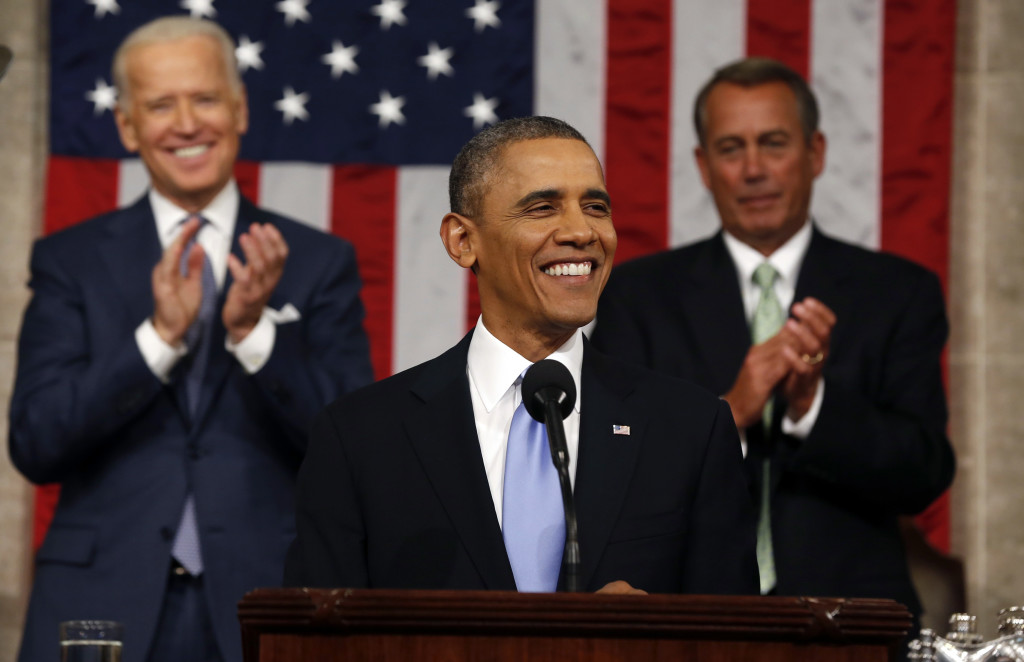Tuesday night, President Obama delivered his State of the Union address. The President’s annual address to Congress (and the country) has been an on-and-off fixture in American politics since the country was founded. The speech acted as a roadmap for the winding down of Obama’s time in office—which sounds as though it will be anything but a winding down.
Early in this nation’s history President Thomas Jefferson refused to present his State of the Union address verbally, fearing that it was too reminiscent of the traditional annual address delivered by the British monarch to his or her government. Since then, however, most presidents have made a habit of delivering the address to the legislature. President Obama was no exception, and to the casual observer his speech offered an enormous departure from Jefferson’s attitude: the United States is still an empire and President Obama is its leader.

President Barack Obama delivers the State of Union address before a joint session of Congress in the House chamber Tuesday, Jan. 28, 2014, in Washington, as Vice President Joe Biden, and House Speaker John Boehner of Ohio, applaud.
Indeed, the President, while certainly not invoking the fiery tone he does when campaigning, did manage to make several bold and significant statements. Perhaps the most important among these? An endorsement of his own executive power and an expression of his willingness to use it to the full extent of his ability in hopes of accomplishing his goals over the next two years should compromise prove impossible.
“…America does not stand still— and neither will I. So wherever and whenever I can take steps without legislation to expand opportunity for more American families, that’s what I’m going to do.”
Perhaps the most significant for readers of this paper is the President’s discussion of continued reforms to education. Specifically, he lamented on the disproportionately growing expense of a college education and the inability of many American high schools to compete with other high school students around the globe.
To remedy rapidly growing college costs, after noting that “taxpayers cannot continue to subsidize” these costs, the President noted that he would ask Congress to rewrite the Higher Education Act to include “affordability and value” as additional qualifying characteristics for colleges seeking federal funding. He also noted that his office would release on Wednesday morning an updated version of its “college report card”, a system designed to evaluate American universities with particular attention paid to the ‘bang-for-their-buck’ students receive at these schools.
As far as K-12 education, the President referenced the success German public schools have found with their unique apprenticeship system and laid out a plan that would incentivize high schools to partner with local colleges and businesses to, in particularly, bolster their students learning in technology, the sciences, and mathematics.
The focus of the evening was, as expected, on the continuing recovery of the American economy. The President celebrated the continued expansion of U.S. manufacturing and the continued decline of certain imports—particularly foreign oil—while reminding the gathered legislators that much work still needs to be done to get the fiscal house of the country in order and rescue an economy that is still, in many ways, struggling. He particularly made note of still-too-high unemployment numbers and the growing disparity between record corporate profits and ever-shrinking wages.
The President also made particular note of continued measures to lower the national deficit, debate over which managed to shut down the government for some time late last year. He congratulated his Administration on the work it has done thus far in slashing about $2 trillion of the $4 trillion in deficit reduction many have deemed necessary for the sustainability of the economy but made note of the urgency with which the government must sort out how to accomplish remaining reduction.
If deficit reduction measures are not agreed upon by the legislature by the March 1 deadline, a $1 trillion collection of cuts (affectionately known as “the sequester”).
The President in particular highlighted two broad policy efforts by which he believes the deficit is best reduced:
1. “Modest reforms” to the overburdened Medicare system. The reforms he seemed to suggest here were very much in line with many of the policies created under the Affordable Care Act, like trying to revamp medical billing for seniors to focus more on quality of care and less on quantity thereof. Even House Speaker John Boehner seemed to find these ideas appealing.
2. Reductions in tax policies to limit the breaks for the nation’s wealthiest and close existing tax loopholes in hopes of reducing the rapidly growing divide between the nation’s wealthiest and the nation’s poorest while simultaneously ensuring a massive new revenue stream to fund ongoing operations. The Speaker’s body language (or more appropriately, lack thereof) seemed to indicate lesser support for this particular policy.
Perhaps some of the President’s most powerful language came when addressing the strength of the American economy relative to other economies around the world, particularly China – this on the heels of recent reports that growth is slowing in China and that economic crisis could be on the horizon for that country as funds prepare to leave that country (pending the Federal Reserve’s expected increase of the interest rate).
In his 12 page speech, the President covered a wide variety of topics and reintroduced several policy points that he had mentioned several times in the recent past. In a White House as notoriously media-conscious as President Obama’s, each word of the State of the Union address was likely carefully scrutinized and vetted before leaving his lips Tuesday night. As the President and Congress continue to battle extremely low polling numbers after a particularly contentious 2013 perhaps the most important takeaway of the speech was the reminder delivered by the president toward the top of his remarks:
“The state of the Union is strong.”








